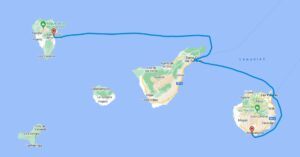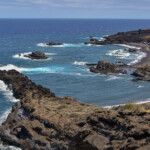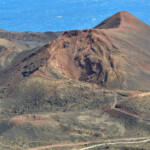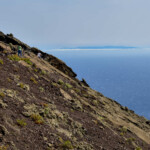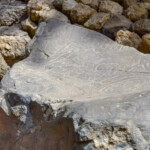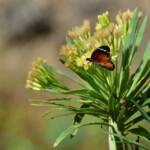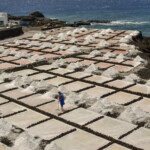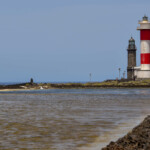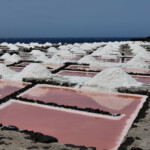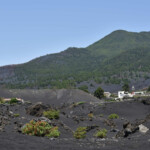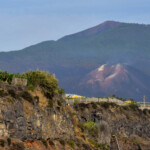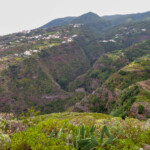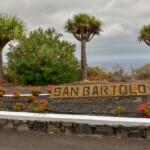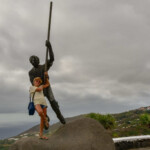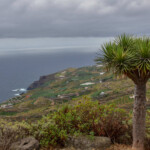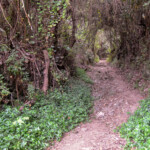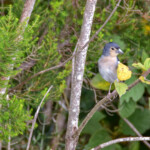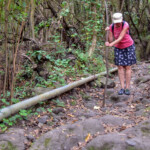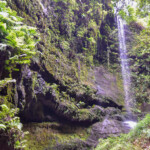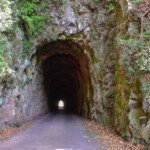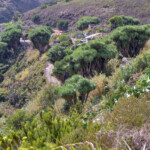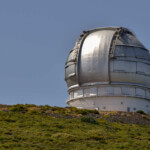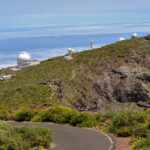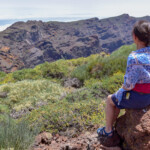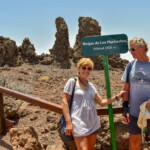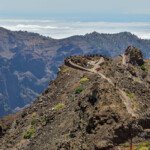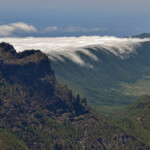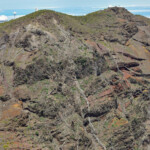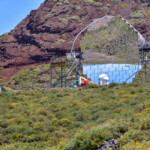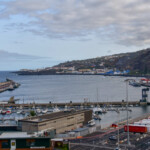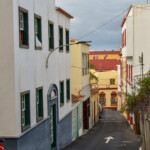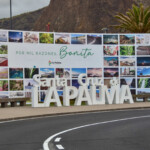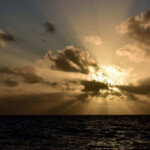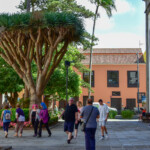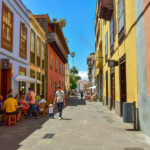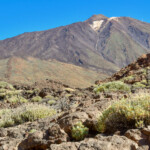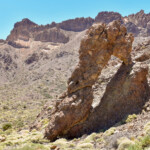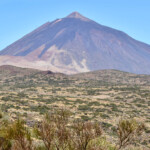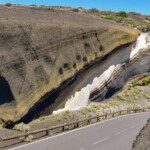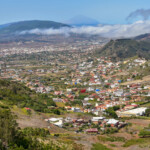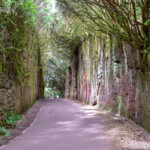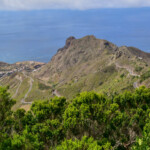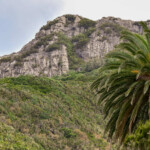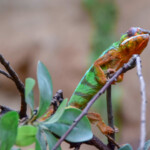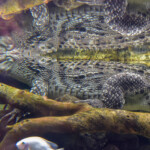La Palma
Santa Cruz
The capital of the island. One of the most beautiful cities not only in La Palma, but also in the Canary Islands. It is worth taking a walk among the perfectly preserved traditional Canarian buildings, seeing the typical Canarian balconies (Balcones tipicos) with flowers and nice finishes, the cathedral (Inglesia Mariz de El Salvador), the Plaza de España (Plaza de Espanola), the replica of the Santa María ship (Barco de la Virgen) ) – an ancient ship with a maritime museum inside, unfortunately it was closed. St. Castle Catherine (Castillo de Santa Catalina) has been under renovation for at least a year, so you can’t go inside.
You can also take the elevator to the upper town (it is staffed, but for free and has a break in the middle of the day). The elevator takes a maximum of 7 people. It has glass walls and you can admire the harbor while driving. It is also worth going to the city market (Mercado Municipial), where you can buy fresh vegetables and fruits, better and cheaper than in the supermarket. The market is open from 6:30 a.m. to 2 p.m.
Centro de Visitantes Volcán San Antonio
Open 9:30-17 admission €8 per person. As part of the tour, we see a room with photos and descriptions (they are also in English), and then we go for a walk to the viewpoint of the San Antonio volcano, a volcano that erupted in 1945. Much of it is already overgrown, but this was compounded by the eruption of the Cumbre Vieja volcano in October 2021, so part of it is covered with fresh volcanic ash.
Archaeological Park Belmaco
Archaeological park with caves and rock drawings (entrance €2 per person). First there are rooms with descriptions and photos, and then the actual caves. There are “bedrooms”, common rooms, rooms for animals, and of course rock drawings that no one has deciphered yet (although many have tried). The area to explore is quite large, and admission is from 10 a.m. to 3 p.m. It’s worth a visit.
Salinas de Fuencaliente
Salt production point in the south of the island – free entry. It is worth seeing the entire process of recovering salt from seawater. There is a designated sightseeing path leading along successive seawater pools. Visiting time is approximately 30 minutes. Along the path there are information boards describing the subsequent stages of salt production. Finally, in the smallest pools, workers remove the salt with special rakes. Very interesting – worth going there. This “factory” produces approximately 800,000 tons of salt per year. Water in swimming pools is sometimes red and sometimes green, depending on the microorganisms that grow in the water.
In the past, water from the sea was pumped by windmills, now it is done by electric pumps. There is a nice restaurant next to salinas with coffee and tasty desserts.
Faro de Fuencaliente
A lighthouse, or rather two, at the end of the island. The original lighthouse was built in 1903, and although it still exists, it was replaced by the current lighthouse in 1985 (painted with red and white stripes).
At the base of the old lighthouse is the Casa del Farero. Apparently you can visit it, although it was not written when, and when we were there it was closed.
Centro de interpretación Caños de Fuego
In the center you can watch the history of the formation of volcanoes, films from subsequent eruptions (mainly the San Juan Volcano eruption in 1949, there is a guided trip to the lava tunnels (unfortunately, after the last eruption, most of the route was closed for safety reasons in 2021 and only one cave was made available). ) There is an additional fee to enter the lava field view point, from there you used to be able to enter the lava tunnels, but now everything is closed. Admission to the entire site costs €12 per person (center, lava tunnels and view point).
The trip would be much more interesting if the volcanic eruption at the end of 2021 did not cause damage (high CO2 levels, dust), as a result of which most of the underground routes are closed.
Marina Tazacorte
Marina on the western side of the island. A well sheltered marina in the middle of nowhere. There are 2 pubs in the marina (one closed) and a travel lift. The nearest civilization is about 1 km away. There are several more bars, a small grocery store and a city beach. The marina surroundings are still under construction. A good place for a one-day stopover, but not a good place to stop to explore the island or to exchange crew. Far from the airport, ferry port or even car rental.
To each of these places you need to travel at least an hour by public transport.
Road through the lava field after the eruption in 2021
In October 2021, the Cumbre Vieja volcano erupted. The eruption lasted 85 days. A new road is being made through the lava field. You can see banana plantations and houses flooded with lava. Apparently, no one died during this eruption, although the material losses were enormous. The path through the tongue of lava is amazing and you can see the power of the explosion and the power of nature. Vapors are coming out of the crack after the explosion (the temperature inside is still about 500 ºC.
Mirador San Bartolo
Viewpoint of the gorge and ocean. This is also a vantage point for observing the sky. There are special boards with a drawing of the star system for specific hours in and months. At the viewpoint there is a monument to Saint Bartolo with his tragic love story – he died trying to prove his love to his beloved by jumping over a cliff using a special stick.
Mirador Cubo de La Galga
We leave the car at the end of the road in La Galga. The viewpoint is approximately 1.5 km away. Important: trail signs are two parallel lines, if the same lines are in the form of a cross, it means that you are on the wrong path. Unfortunately, we found out about it only after 15 minutes of walking. The actual trail leads through a beautiful gorge, although quite steep.
Bosque de Los Tiles
A beautiful place with a waterfall among the forests. You go to the waterfall through a rock tunnel. The waterfall is high and you can swim under it. Above is the Centro de Visitantes – with posters about the natural values of the environment and an exhibition about flora and fauna, the importance of water and human activity. The area is ideal for walking and offers good hiking opportunities.
Road LP-109
A beautiful road with tunnels carved in the rock. There are numerous miradors along the road, including: Mirador de La Mimbreras and Mirador Barranco de Los Poleos with beautiful views of the surrounding valleys. The road is narrow, has some passing places, but the views are unforgettable.
Mirador Dragos La Tosca
Viewpoint with the largest number of dracaenas in the Canary Islands. They are big and lots of them. They can be reached by car via a narrow local road that ends at the dracaena trees.
Roque de los Muchachos Observatory
The astronomical observatory is one of the three best in the world. They have the largest telescope in the world – the dome is 33 meters high. The observatory is on the slope of the highest mountain on the island, 2,426 meters high. This is a place where there are virtually no clouds. The Astrophysical Observatory consists of 16 telescopes, varying in size depending on the purpose of research. Construction is still ongoing and more telescopes are being rebuilt. You can buy tickets for a tour to visit the observatory. You need to book well in advance. Tickets cost €20 per person. The maximum group of visitors is 22 people. During the tour, the lady talks about the observatory – especially for us in English, and for the rest in Spanish. We also visit the largest telescope. This is a once in a lifetime opportunity.
Roque de los Muchachos 2426m
The highest peak of La Palma. You can enter it by car. From the top there is a path to the next miradors. The views are amazing. The walk takes about an hour. The other miradors are below, but it’s worth going to them.
Tenerife
Marina Santa Cruz
Before entering the marina, you must report to Port Control on channel 12VHF and ask for permission to enter the marina and pass through the port. Then you need to report to the marina on 9VHF. A place in the marina must be reserved, although in the off-season it can be done by calling the marina the day before. It happens in Y-booms and floating piers. There are also places with the stern to the pier and the bow on the moorings, although these places are used when there are no others. Entry to the pier is by card (deposit €10). The same cards are used to enter toilets and showers. Nearby there is the Spanish Square and the Spar store.
Santa Cruz
The capital of the island and province. A nice town with four sailing shops, a whole bunch of pubs and shops. There are also many “Chinese” shops. It is worth visiting the Palm House (entrance €6) – it is a botanical garden with palm trees from all over the world. There are designated sightseeing routes, and the leaflet with the sightseeing route is also in Polish. The Palm House is open until 6 p.m. (last entry at 5 p.m.), but it is worth spending 2-3 hours there.
La Laguna
The second largest city of Tenerife is located in its north-western part. An extremely charming town inscribed on the UNESCO World Cultural and Natural Heritage List in 1999. The history of this city dates back to the 15th century. Beautiful old residences with elegant facades have been preserved. You can get to La Laguna from Santa Cruz by tram number 1 (last stop). La Laguna – was the capital of the island until 1723. It is worth walking along the nice, clean streets and admiring the well-preserved houses from the 16th and 19th centuries. The town is colorful, full of pubs and souvenir shops. It is colder there than in Santa Cruz (about 500m higher).
El Teide
To climb El Teide, you need a permit (https://www.reservasparquesnacionales.es/real/ParquesNac/usu/html/detalle-actividad-oapn.aspx?cen=2&act=1).
The permit is free, but must be booked about 3 months in advance. ID numbers of all people in the group are needed, but if someone is not entirely sure, it is better to book separately – it is not possible to cancel the reservation of one person from the group or replace one person with another.
The next step is to buy tickets for the El Teide cable car. Here you can reduce the number of group members – then they return the money to the account from which the payment was made.
In case of bad weather conditions, the queue does not run, so tickets will be refunded. The road to the cable car is picturesque, full of miradors – they are marked with a sign with a camera – it is worth stopping there to admire the views and take a few photos.
Anaga Rural Park
A nature reserve in the north-eastern part of the island. Very picturesque, green, full of gorges, winding roads and viewpoints. Passing a bus on the road is quite a challenge. The road ends in Chamorga, and the bus goes there. There are many hiking trails along the way. It is full of laurel forests and ravines with trees and protruding roots.
Gran Canaria
Marina Las Palmas
Information about the marina is here:
Lanzarote-Gran Canaria
Las Palmas
The general outline of the city is described here:
Gran Canaria-La Gomera
Poema del Mar Oceanarium
Poema del Mar, or “Poem of the Sea”, is a modern oceanarium in Las Palmas de Gran Canaria.
Open from 9:30 a.m. to 5:30 p.m. admission €27 per person. You can visit it by walking through both “rock” and water tunnels – You can admire over 350 species of sea inhabitants. It consists of three large, diverse zones: surface, deep-sea and freshwater marine ecosystems. 35 ecosystems are represented in different aquariums, giving a total of 7.5 million liters of water. There is one of the largest aquariums in the world with a curved surface measuring 36 meters long and 7 meters high.



